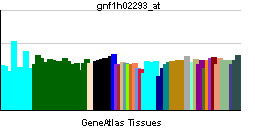CAPN3: Difference between revisions
Jump to navigation
Jump to search
m (Bot: Automated text replacement (-{{SIB}} + & -{{EH}} + & -{{EJ}} + & -{{Editor Help}} + & -{{Editor Join}} +)) |
m (Robot: Automated text replacement (-{{WikiDoc Cardiology Network Infobox}} +, -<references /> +{{reflist|2}}, -{{reflist}} +{{reflist|2}})) |
||
| Line 59: | Line 59: | ||
==References== | ==References== | ||
{{reflist}} | {{reflist|2}} | ||
==Further reading== | ==Further reading== | ||
{{refbegin | 2}} | {{refbegin | 2}} | ||
Revision as of 14:57, 4 September 2012
| Calpain 3, (p94) | |||||||||||
|---|---|---|---|---|---|---|---|---|---|---|---|
| Identifiers | |||||||||||
| Symbols | CAPN3 ; CANP3; CANPL3; LGMD2; LGMD2A; MGC10767; MGC11121; MGC14344; MGC4403; nCL-1; p94 | ||||||||||
| External IDs | Template:OMIM5 Template:MGI HomoloGene: 52 | ||||||||||
| |||||||||||
| RNA expression pattern | |||||||||||
 | |||||||||||
 | |||||||||||
 | |||||||||||
| More reference expression data | |||||||||||
| Orthologs | |||||||||||
| Template:GNF Ortholog box | |||||||||||
| Species | Human | Mouse | |||||||||
| Entrez | n/a | n/a | |||||||||
| Ensembl | n/a | n/a | |||||||||
| UniProt | n/a | n/a | |||||||||
| RefSeq (mRNA) | n/a | n/a | |||||||||
| RefSeq (protein) | n/a | n/a | |||||||||
| Location (UCSC) | n/a | n/a | |||||||||
| PubMed search | n/a | n/a | |||||||||
Calpain 3, (p94), also known as CAPN3, is a human gene.
Calpain, a heterodimer consisting of a large and a small subunit, is a major intracellular protease, although its function has not been well established. This gene encodes a muscle-specific member of the calpain large subunit family that specifically binds to titin. Mutations in this gene are associated with limb-girdle muscular dystrophies type 2A. Alternate promoters and alternative splicing result in multiple transcript variants encoding different isoforms and some variants are ubiquitously expressed.[1]
References
Further reading
- Sorimachi H, Ishiura S, Suzuki K (1998). "Structure and physiological function of calpains". Biochem. J. 328 ( Pt 3): 721–32. PMID 9396712.
- Kinbara K, Sorimachi H, Ishiura S, Suzuki K (1998). "Skeletal muscle-specific calpain, p49: structure and physiological function". Biochem. Pharmacol. 56 (4): 415–20. PMID 9763216.
- Sorimachi H, Ono Y, Suzuki K (2000). "Skeletal muscle-specific calpain, p94, and connectin/titin: their physiological functions and relationship to limb-girdle muscular dystrophy type 2A". Adv. Exp. Med. Biol. 481: 383–95, discussion 395–7. PMID 10987085.
- Baghdiguian S, Richard I, Martin M; et al. (2002). "Pathophysiology of limb girdle muscular dystrophy type 2A: hypothesis and new insights into the IkappaBalpha/NF-kappaB survival pathway in skeletal muscle". J. Mol. Med. 79 (5–6): 254–61. PMID 11485017.
- Canki-Klain N, Milic A, Kovac B; et al. (2004). "Prevalence of the 550delA mutation in calpainopathy (LGMD 2A) in Croatia". Am. J. Med. Genet. A. 125 (2): 152–6. doi:10.1002/ajmg.a.20408. PMID 14981715.
- Kramerova I, Beckmann JS, Spencer MJ (2007). "Molecular and cellular basis of calpainopathy (limb girdle muscular dystrophy type 2A)". Biochim. Biophys. Acta. 1772 (2): 128–44. doi:10.1016/j.bbadis.2006.07.002. PMID 16934440.
- Ohno S, Minoshima S, Kudoh J; et al. (1990). "Four genes for the calpain family locate on four distinct human chromosomes". Cytogenet. Cell Genet. 53 (4): 225–9. PMID 2209092.
- Sorimachi H, Imajoh-Ohmi S, Emori Y; et al. (1989). "Molecular cloning of a novel mammalian calcium-dependent protease distinct from both m- and mu-types. Specific expression of the mRNA in skeletal muscle". J. Biol. Chem. 264 (33): 20106–11. PMID 2555341.
- Richard I, Broux O, Allamand V; et al. (1995). "Mutations in the proteolytic enzyme calpain 3 cause limb-girdle muscular dystrophy type 2A". Cell. 81 (1): 27–40. PMID 7720071.
- Sorimachi H, Kinbara K, Kimura S; et al. (1996). "Muscle-specific calpain, p94, responsible for limb girdle muscular dystrophy type 2A, associates with connectin through IS2, a p94-specific sequence". J. Biol. Chem. 270 (52): 31158–62. PMID 8537379.
- Fardeau M, Hillaire D, Mignard C; et al. (1996). "Juvenile limb-girdle muscular dystrophy. Clinical, histopathological and genetic data from a small community living in the Reunion Island". Brain. 119 ( Pt 1): 295–308. PMID 8624690.
- Corasaniti MT, Navarra M, Catani MV; et al. (1997). "NMDA and HIV-1 coat protein, GP120, produce necrotic but not apoptotic cell death in human CHP100 neuroblastoma cultures via a mechanism involving calpain". Biochem. Biophys. Res. Commun. 229 (1): 299–304. doi:10.1006/bbrc.1996.1796. PMID 8954122.
- Richard I, Brenguier L, Dinçer P; et al. (1997). "Multiple independent molecular etiology for limb-girdle muscular dystrophy type 2A patients from various geographical origins". Am. J. Hum. Genet. 60 (5): 1128–38. PMID 9150160.
- Kinbara K, Sorimachi H, Ishiura S, Suzuki K (1997). "Muscle-specific calpain, p94, interacts with the extreme C-terminal region of connectin, a unique region flanked by two immunoglobulin C2 motifs". Arch. Biochem. Biophys. 342 (1): 99–107. doi:10.1006/abbi.1997.0108. PMID 9185618.
- Pratt VM, Jackson CE, Wallace DC; et al. (1997). "DNA studies of limb-girdle muscular dystrophy type 2A in the Amish exclude a modifying mitochondrial gene and show no evidence for a modifying nuclear gene". Am. J. Hum. Genet. 61 (1): 231–3. PMID 9246005.
- Dinçer P, Leturcq F, Richard I; et al. (1997). "A biochemical, genetic, and clinical survey of autosomal recessive limb girdle muscular dystrophies in Turkey". Ann. Neurol. 42 (2): 222–9. doi:10.1002/ana.410420214. PMID 9266733.
- Ono Y, Shimada H, Sorimachi H; et al. (1998). "Functional defects of a muscle-specific calpain, p94, caused by mutations associated with limb-girdle muscular dystrophy type 2A". J. Biol. Chem. 273 (27): 17073–8. PMID 9642272.
- Pénisson-Besnier I, Richard I, Dubas F; et al. (1998). "Pseudometabolic expression and phenotypic variability of calpain deficiency in two siblings". Muscle Nerve. 21 (8): 1078–80. PMID 9655129.
- Urtasun M, Sáenz A, Roudaut C; et al. (1998). "Limb-girdle muscular dystrophy in Guipúzcoa (Basque Country, Spain)". Brain. 121 ( Pt 9): 1735–47. PMID 9762961.